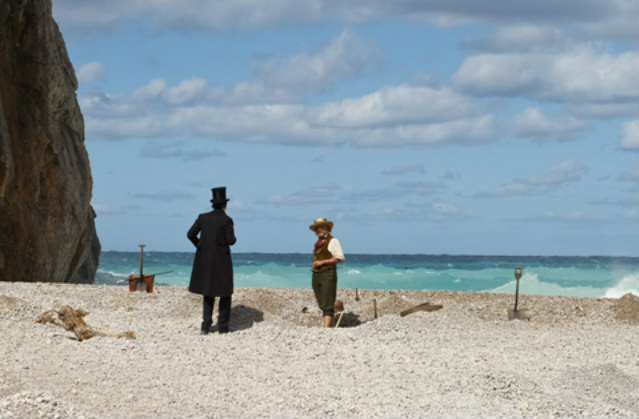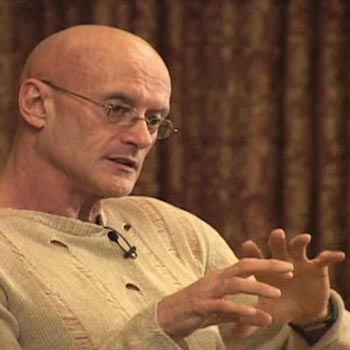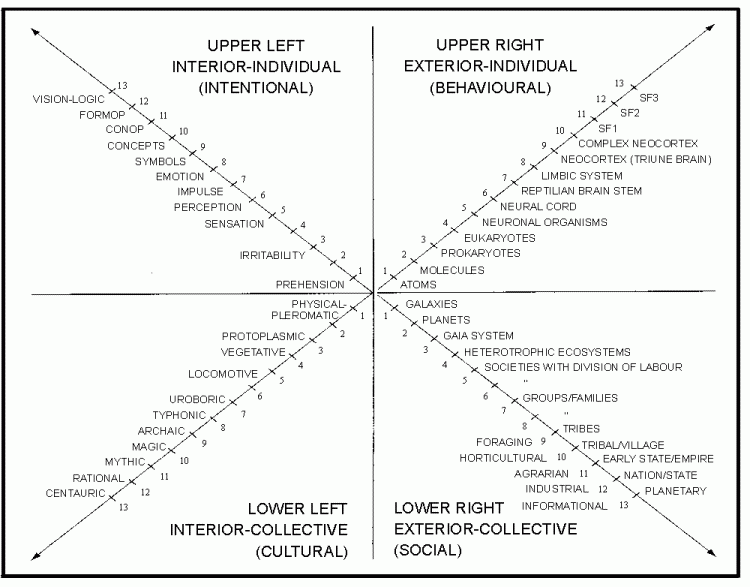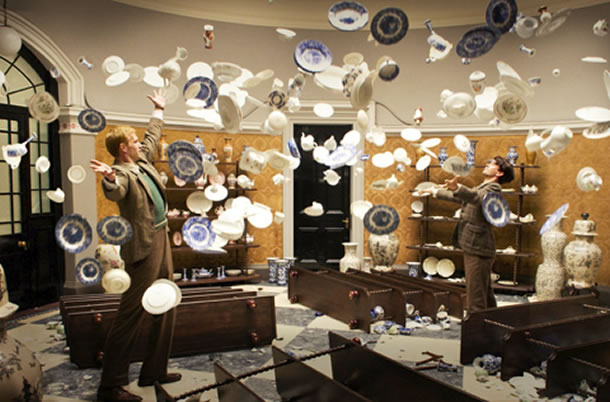Cloud Atlas, the unlikely new adaptation by Lana and Andy Wachowski and Tom Tykwer of David Mitchell’s ingenious novel, should do well on DVD, a format whose capacity for endless replay will enable viewers to study at leisure the myriad concurrences binding the movie’s half dozen plots. Better yet, the directors should hire their friend the philosopher Ken Wilber to provide expert commentary and spare us from having to hit “pause” and “reverse.”
Ken Wilber? In academic circles, Wilber remains obscure. A sixty-three-year-old autodidact, he is the author of an ambitious effort to reconcile empirical knowledge and mystical experience in an “Integral Theory” of existence. Yet his admirers include not only the alternative-healing guru Deepak Chopra—who has called Wilber “one of the most important pioneers in the field of consciousness”—but also the philosopher Charles Taylor, the theologians Harvey Cox and Michael Lerner, and Bill Clinton. Wilber’s generally lucid treatments of both Western science and Eastern spirituality have earned him favor with a coterie of highly literate seekers for whom the phrase “New Age” is nonetheless suspect. He’s an intellectual’s mystic, short on ecstatic visions and long on exegeses of Habermas (whom he regards, for his perception of “homologous structures” in human individual and social development, as something of a kindred spirit). At the Integral Institute, a Colorado-based think tank inspired by Wilber’s ideas, scholars like Jack Crittenden, a professor of political theory at Arizona State University, strive to apply his approach to “global-scale problems,” from climate change to religious conflict.
All of which makes Wilber a natural ally of the Wachowski siblings, whose films tend to reflect a similar grandiosity of ambition. In 2004, Wilber was one of two thinkers—the other was Cornel West—that they invited to deliver a “philosophers’ commentary” on a DVD edition of the Matrix trilogy, their brainy sci-fi masterwork. In Wilber’s take, the movies’ ostensibly Manichean premise—good humans and evil machines duking it out on an illusory electronic terrain—conceals a sophisticated philosophical allegory about a fallen world groping toward enlightenment. He is particularly taken with the trilogy’s concluding minutes, in which Neo, the hacker hero, willingly succumbs to Agent Smith, his digital nemesis, and both dissolve into streams of light. This final twist, Wilber contends, is a sign that the necessary “reintegration” of body (humans), mind (the matrix), and spirit (machines) is underway, not to mention proof of an unusually developed directorial consciousness. “To think they had the nerve to put that stuff into a commercial blockbuster like this is an absolutely rare deed!” he exclaims at one point.
In their Matrix commentary, Wilber and West name-checked most of philosophy’s leading lights, from Plato and Descartes to Schopenhauer, Emerson, and the ancient Hindu authors of the Upanishads. A similar list of influences on Cloud Atlas would surely include Wilber’s own name somewhere near the top. The film, which runs to nearly three hours and careers through time, places, genres, and storylines, relying on a small ensemble of big-ticket actors to play as many as six roles each, has largely baffled critics. Manohla Dargis, of The New York Times, called it a “megabucks hash of time, space, and cinema” that “weaves together multiple stories through a lot of airy cosmic convenience and a cavalcade of false noses.” Much of the bewilderment may be explained by the Wachowskis’ philosophical predilections; their movie appears to owe as much to Wilber’s brand of cerebral mysticism as to Mitchell’s fiction, a circumstance that, at least with respect to box-office revenue, is likely to be a disadvantage.
Cloud Atlas the novel is a marvel, a singular parable about the human race’s dueling capacities for self-annihilation and survival comprised of six disparate sections, sliced and shuffled, as in a card trick, to yield a suggestively resonant whole. The strands include an American notary’s maritime diary of a voyage through the South Pacific in the 1840s; the letters of a dissolute musical prodigy in pre-war rural Belgium; the final testimony of a genetically engineered fast-food worker awaiting execution in a twenty-second-century police state; and the oral epic of a goatherd living hand-to-mouth on a Hawaiian island in a distant, post-apocalyptic future, a place where English has devolved into a memorably salty pidgin. (“I’d got diresome hole-spew that day ‘cos I’d ate a gammy dog leg in Honokaa….”) Mitchell’s fecund imagination and skill as a ventriloquist have been amply noted; the novel’s six narrators are utterly distinct yet equally eloquent.
The virtuosity extends to the book’s Russian doll construction: each section becomes a text that is read—or, in one case, a film that is viewed—by a character in the succeeding one. Thus Robert Frobisher, the musical prodigy, is entranced by the diary of Adam Ewing, the seafaring notary, which he discovers in his room at the Belgian chateau belonging to the syphilitic composer to whom he is serving as amanuensis. In turn, Frobisher’s letters preoccupy Luisa Rey, the heroine of the third section, an intrepid reporter in 1970s southern California intent on exposing a corrupt oil company. Rey retrieves Frobisher’s letters from a hotel room where his lover, now an aging nuclear scientist, was murdered. Then, in the fourth section, Rey’s saga arrives as a manuscript submission by an aspiring crime-thriller writer in the mailbox of Timothy Cavendish, a hack publisher in contemporary London. And so on.
Advertisement
Other mysterious bonds connect the sections, including a comet-shaped birthmark shared by five protagonists, men and women both, living hundreds of years apart. The reader encounters all but one of the sections twice, first in chronological order, and then, after the sixth section, in reverse, so that the novel collapses in on itself like a folding telescope, ending where it began, with Adam Ewing’s diary, in the 1840s.
Ken Wilber’s Integral Theory, elaborated over the course of thirty-five years and in more than twenty densely argued books, features a similar nested design. In simplified form, it says something like this: reality is composed exclusively of holons, a term borrowed from Arthur Koestler to denote that which is simultaneously an autonomous whole and a part of something larger. Just as a brain cell is both a self-contained unit and part of a larger organ, so, too, a human being exists as a single individual and as part of a larger collective—a family, an ethnic group, the human race, all living things—in a pattern that extends indefinitely in both directions. It’s holons all the way up and all the way down.
According to Wilber, even consciousness evolves in holarchical fashion, so that the “amount of consciousness” in any given holon is greater than that of its constituents, which it incorporates and transcends, yielding distinctive new forms. He is less interested in definitions—as he points out, there’s no consensus about what consciousness is, let alone which life forms have it—than in the grand pattern. “It really does not matter, as far as I’m concerned, how far down (or not) you wish to push consciousness,” he writes in Sex, Ecology, Spirituality. “The important point…is simply that each new and emergent interior holon transcends but includes, and thus operates upon, the information presented by its junior holons, and thus it fashions something novel in the ongoing cognitive or interior stream.”
Wilber is an ecumenical taxonomist; he doesn’t choose between materialist and idealist accounts of consciousness. Competing schools of knowledge, he suggests, merely reflect limitations of perspective, a problem that conveniently disappears once all more or less plausible points of view are properly integrated, “not on the level of details—that is finitely impossible; but on the level of orienting generalizations.” He is big on labels and diagrams. No doubt part of his appeal is a talent for reducing complex phenomena to a flowchart. Who wouldn’t want a map of reality that fits in a wallet?
In his schema, the highest form of consciousness is “transpersonal,” a state in which identification with the divine unity (“World Soul”) underlying all things is possible, if rarely achieved. Wilber, who is not known for intellectual modesty, told the science writer John Horgan that he can sustain this “nondual” awareness in deep sleep, something he claimed not even the Dalai Lama can do. But even as we take baby steps toward enlightenment, human history is stuck on endless repeat. “The mystics are pretty sure about this,” Wilber told Horgan. “This has happened a gazillion times; it’ll happen another gazillion.”
With Lana Wachowski, Wilber apparently established an instant rapport. “You and I both are, you know, we’re integrally informed,” he remarks during a 2004 conversation with Lana—who is transgender and was then called Larry—according to a transcript posted on Wilber’s website. “You’ve been interested in this as long as I have, in terms of, you know, the span of your adult life. When you and I first talked on the phone…we spent three and a half hours, and it was non-stop talking about all these things.” Larry confirms Wilber’s account—“it was like one of those great moments where you meet someone, and you talk, and you have a confirmation or a validation about the world”—and tells him that she and her father are reading Sex, Ecology, Spirituality together.
Two years later, in a giddy blog post about the New York premier of V for Vendetta, which Wilber attended at the Wachowskis’ invitation (the siblings wrote the screenplay), he describes Larry as among the “most brilliant minds that I have jumped into a dance of intersubjectivity with,” adding,
Advertisement
Larry will begin a single sentence with a quote from the Upanishads and Schopenhauer, weave it through different interpretations of Chekhov and Tolstoy, and end up—in the same sentence, mind you—with their relationship to recent digital video games. I have honestly never seen anything like it.
(Wilber, who is apparently not so enlightened that he is immune to the ego-trip of the red carpet, also gives a breathless account of his limo ride, his encounter with John Hurt, and his date’s Alexander McQueen gown, in which she “outshone even Natalie Portman.”)
The Wachowskis are notoriously press-shy. One of their few explicit statements regarding their intellectual vision for Cloud Atlas is in a YouTube trailer, online since July, in which they and Tykwer invoke themes of “connectedness and karma,” while admitting that the movie is “hard to sell because it is hard to describe.” But their decision to have the same actors play characters in different storylines, and to shuttle among all the plots at once, is telling. With these gestures, the directors made literal what Mitchell had left playfully ambiguous: characters in later sections are the spiritual embodiments—reincarnations—of those in earlier ones.
Thus, in the movie, Luisa Rey (Halle Berry), doesn’t just share a birthmark with Robert Frobisher, the musical prodigy; as Jocasta, the bored young wife of the aged composer Frobisher works for, Berry actually sleeps with him—and so, by the power of transitivity, does Rey. The bad karma racked up by characters Tom Hanks plays in earlier storylines, including a quack doctor who tries to poison Adam Ewing in order to rob him, is more than compensated for centuries later by Hanks’ heroic behavior as Zachry, the goatherd, who undertakes to save what’s left of the human race from certain self-destruction. (Got that?)
Characters with and without birthmarks are captured, enslaved, liberated, and transformed, and the actors who play them cross ethnic and gender as well as temporal barriers. The Korean actress Doona Bae plays both Sonmi-451, the futuristic fast-food drone, and, with far less conviction, Adam Ewing’s red-haired San Franciscan wife. Viewers are asked to take all this in while absorbing a steady stream of heady apercus—“From womb to tomb we are bound to others; with each crime and every kindness, we birth our future”—and hurtling between sets whose lavish detail far exceeds the requirements of plot and which are evidently intended as tributes to entire cinematic genres, including noir, anime, and Merchant-Ivory.
During the film’s opening sequence, as we are whisked through half a dozen scenes, each in medias res and taking place decades and sometimes centuries apart, Timothy Cavendish (the delightful Jim Broadbent) pleads forbearance: “If you extend your patience for just a moment, there is a method to this tale of madness.” Surely he’s right, and that’s part of the problem. So intent are the Wachowskis and Tykwer on delivering the movie’s mystical tidings—we’re not just bodies, but also souls (or even holons); the choices we make in one life affect who we become in another; we’re all connected to each other and to something bigger than ourselves—that the film risks the earnest impenetrability of a New Age infomercial.
It’s easy to see how Mitchell’s novel, with its nested construction, mysterious concordances, and perpetually recurring birthmark, could give off a Wilberite allure. And to be fair, Mitchell gave the film script his blessing (though he has also told reporters that he considered his book “unfilmable.”) Yet where the filmmakers evangelize, Mitchell treads lightly, with a mischievous wink. For every implied connection between two characters across time and space, another character pooh-poohs the very notion. As Timothy Cavendish, the London publisher, says when he accepts “Half-Lives: the First Luisa Rey Mystery” for publication:
One or two things will have to go: the insinuation that Luisa Rey is this Robert Frobisher chap reincarnated, for example. Far too hippie-druggy-new age. (I too have a birthmark below my left armpit, but no lover ever compared it to a comet.)
And, of course, as Mitchell reminds us, “Half-Lives,” like the novel’s other sections, is a work of fiction, not to be confused with truth.
Mitchell has said that he doesn’t believe in reincarnation, at least not for human beings. (He told an interviewer that he intended the birthmark as a symbol of “the universality of human nature.” ) In his fiction, however, the same names tend to recur from one book to the next. In his first novel, Ghostwritten, Luisa Rey makes a brief appearance as a true-crime writer who calls in to a late-night radio show. Her name is itself an homage to a work of fiction: Thornton Wilder’s The Bridge of San Luis Rey, another imaginative exploration of the metaphysical bond connecting a seemingly random group of people. In that novel, a lonely society matron veers between despair that “the world had no plan in it” and a flicker of belief in what Wilder eloquently terms “the great Perhaps.” Belief in the great Perhaps suffuses Cloud Atlas the novel; the misstep of Cloud Atlas the film is to try to turn Perhaps into Certainty.






